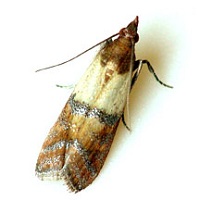Indianmeal Moth Infestations in Bird Seed

The Indianmeal moth is a common pest of grain-based foods and animal feed. Bird seed and products containing bird seed can be particularly attractive to this pest. Products like bird seed go through minimal processing and are not cooked. There are fewer opportunities to kill the pest through heat or mechanical control.
Identification
The Indianmeal moth adult is a relatively small moth with bi-colored wings. Adults may be seen flying near infested products or you may observe the immature stage, called larva, inside or around infested products. The larva is typically off white in color with a brown head. It can reach lengths of ½ inch when fully grown. The last tell-tale sign is the pupal stage. The pupal stage is the developmental stage prior to adult. It is wrapped in webbing. Pupa are often found in the seams or folds of boxes and bags. Other common areas to find pupa include shelf peg boards and crevices around shelving.
4 Stages of Development
It can complete development in as short as 27 days when conditions are favorable.

What can you do?
- Notify your pest management professional if you see or suspect an Indianmeal moth infestation.
- Review the pest management service reports with your pest control provider at the end of each service. Follow up on
recommendations listed on the report. - Check immediately any incoming products for signs of the different Indianmeal moth stages and webbing. Reject any
infested shipments. Notify the shipper. - Use a first in, first out (FIFO) system of stock rotation. The longer a product remains in storage, the more likely it will
become infested. - Keep reclaim and damaged products storage areas cleaned daily to assure that all exposed products have a proper
disposition. - Keep doors closed when not in use and door seals maintained. Vents should have screens and/or filters to prevent
pest entry. This stored product pest can come inside from the exterior. It does not have to arrive via product shipments. - If an infestation is found, a thorough cleaning of spillage and infested area will be required. Removal of the pupal and
larval stages will be needed. - Infested product should be moved to freezer or discarded in an exterior dumpster as quickly as possible to prevent
spreading of the infestation.
